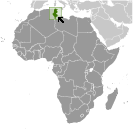World Atlas: Tunisia. On this page you can see the map, country flag and many detailed information about the people, history and economy of Tunisia.

Here you can find online selected information about the geography, inhabitants, government, economy and history of Tunisia. Included are selected statistics, an overview map and the detailed map of Tunisia. But let's start with the flag of Tunisia here:
Tunisia - Overview:
What you should know about Tunisia? Let's start with this: Rivalry between French and Italian interests in Tunisia culminated in a French invasion in 1881 and the creation of a protectorate. Agitation for independence in the decades following World War I was finally successful in convincing the French to recognize Tunisia as an independent state in 1956. The country's first president, Habib Bourguiba, established a strict one-party state. He dominated the country for 31 years, repressing Islamic fundamentalism and establishing rights for women unmatched by any other Arab nation. In November 1987, Bourguiba was removed from office and replaced by Zine el Abidine BEN ALI in a bloodless coup. Street protests that began in Tunis in December 2010 over high unemployment, corruption, widespread poverty, and high food prices escalated in January 2011, culminating in rioting that led to hundreds of deaths. On 14 January 2011, the same day BEN ALI dismissed the government, he fled the country, and by late January 2011, a "national unity government" was formed. Elections for the new Constituent Assembly were held in late October 2011, and in December, it elected human rights activist Moncef Marzouki as interim president. The Assembly began drafting a new constitution in February 2012 and, after several iterations and a months-long political crisis that stalled the transition, ratified the document in January 2014. Parliamentary and presidential elections for a permanent government were held at the end of 2014. Beji CAID Essebsi was elected as the first president under the country's new constitution. In 2016, the new unity government continued to seek to balance political cohesion with economic and social pressures.
Geography of Tunisia
 Where on the globe is Tunisia? The location of this country is Northern Africa, bordering the Mediterranean Sea, between Algeria and Libya. Total area of Tunisia is 163,610 sq km, of which 155,360 sq km is land. So this is not a large country. How could we describe the terrain of the country? This way: mountains in north; hot, dry central plain; semiarid south merges into the Sahara. The lowest point of Tunisia is Shatt al Gharsah -17 m, the highest point Jebel ech Chambi 1,544 m. And the climate is temperate in north with mild, rainy winters and hot, dry summers; desert in south.
Where on the globe is Tunisia? The location of this country is Northern Africa, bordering the Mediterranean Sea, between Algeria and Libya. Total area of Tunisia is 163,610 sq km, of which 155,360 sq km is land. So this is not a large country. How could we describe the terrain of the country? This way: mountains in north; hot, dry central plain; semiarid south merges into the Sahara. The lowest point of Tunisia is Shatt al Gharsah -17 m, the highest point Jebel ech Chambi 1,544 m. And the climate is temperate in north with mild, rainy winters and hot, dry summers; desert in south.
Inhabitants of Tunisia
Let's take a look how many people live in Tunisia. The number is: 11,403,800 (July 2017 est.). So this is not very populous country. Who lives here? Arab 98%, European 1%, Jewish and other 1%. What are the languages in Tunisia? Arabic (official, one of the languages of commerce), French (commerce), Berber (Tamazight). And the religions: Muslim (official; Sunni) 99.1%, other (includes Christian, Jewish, Shia Muslim, and Baha'i) 1%. How old are the people in average? 31.6 years. We have to add that this number is the median - so one half of the people is older than this, one half is younger. And what is their life expectancy (at birth)? This: 75.7 years. Where the people live in Tunisia? Here: the overwhelming majority of the population is located in the northern half of the country; the south remains largely underpopulated. The major urban areas of Tunisia are: Tunis (capital) 1.993 million (2015).
Government and Economy of Tunisia
The capital of Tunisia is Tunis and the government type parliamentary republic. Let's take a look at the administrative divisions - 24 governorates (wilayat, singular - wilayah); Beja (Bajah), Ben Arous (Bin 'Arus), Bizerte (Banzart), Gabes (Qabis), Gafsa (Qafsah), Jendouba (Jundubah), Kairouan (Al Qayrawan), Kasserine (Al Qasrayn), Kebili (Qibili), Kef (Al Kaf), L'Ariana (Aryanah), Mahdia (Al Mahdiyah), Manouba (Manubah), Medenine (Madanin), Monastir (Al Munastir), Nabeul (Nabul), Sfax (Safaqis), Sidi Bouzid (Sidi Bu Zayd), Siliana (Silyanah), Sousse (Susah), Tataouine (Tatawin), Tozeur (Tawzar), Tunis, Zaghouan (Zaghwan). Regarding the economy of Tunisia, important industrial products are petroleum, mining (particularly phosphate, iron ore), tourism, textiles, footwear, agribusiness, beverages. Important agricultural products are olives, olive oil, grain, tomatoes, citrus fruit, sugar beets, dates, almonds; beef, dairy products. The most important export commodities are clothing, semi-finished goods and textiles, agricultural products, mechanical goods, phosphates and chemicals, hydrocarbons, electrical equipment and the most important export partners are France 30.1%, Italy 19.3%, Germany 10.7%, Spain 5.2%, Libya 4.3% (2016). The most important import commodities are textiles, machinery and equipment, hydrocarbons, chemicals, foodstuffs and the most important import partners are France 18%, Italy 14.8%, China 8%, Germany 7.3%, Spain 4.3%, Algeria 4.1% (2016). How rich is Tunisia and how rich are people in this country? The most important number here is GDP per capita (PPP): $12,000 (2017 est.). This is quite good. Let's add that this means Gross Domestic Product per person, which is recalculated with respect to the relative cost of local goods and services. And one more important number - population below poverty line: 15.5% (2010 est.).